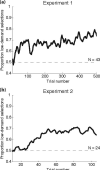Decision making and the avoidance of cognitive demand
- PMID: 20853993
- PMCID: PMC2970648
- DOI: 10.1037/a0020198
Decision making and the avoidance of cognitive demand
Abstract
Behavioral and economic theories have long maintained that actions are chosen so as to minimize demands for exertion or work, a principle sometimes referred to as the law of less work. The data supporting this idea pertain almost entirely to demands for physical effort. However, the same minimization principle has often been assumed also to apply to cognitive demand. The authors set out to evaluate the validity of this assumption. In 6 behavioral experiments, participants chose freely between courses of action associated with different levels of demand for controlled information processing. Together, the results of these experiments revealed a bias in favor of the less demanding course of action. The bias was obtained across a range of choice settings and demand manipulations and was not wholly attributable to strategic avoidance of errors, minimization of time on task, or maximization of the rate of goal achievement. It is remarkable that the effect also did not depend on awareness of the demand manipulation. Consistent with a motivational account, avoidance of demand displayed sensitivity to task incentives and covaried with individual differences in the efficacy of executive control. The findings reported, together with convergent neuroscientific evidence, lend support to the idea that anticipated cognitive demand plays a significant role in behavioral decision making.
Figures







Similar articles
-
The role of cognitive effort in subjective reward devaluation and risky decision-making.Sci Rep. 2015 Nov 20;5:16880. doi: 10.1038/srep16880. Sci Rep. 2015. PMID: 26586084 Free PMC article.
-
Changes in cognitive function and latent processes of decision-making during incremental ascent to high altitude.Physiol Behav. 2019 Mar 15;201:139-145. doi: 10.1016/j.physbeh.2019.01.002. Epub 2019 Jan 3. Physiol Behav. 2019. PMID: 30611763
-
Local and global effects of motivation on cognitive control.Cogn Affect Behav Neurosci. 2012 Dec;12(4):692-718. doi: 10.3758/s13415-012-0113-y. Cogn Affect Behav Neurosci. 2012. Retraction in: Cogn Affect Behav Neurosci. 2013 Sep;13(3):586. doi: 10.3758/s13415-013-0183-5. PMID: 22875410 Retracted.
-
Sleep deprivation, effort allocation and performance.Prog Brain Res. 2019;246:1-26. doi: 10.1016/bs.pbr.2019.03.007. Epub 2019 Apr 3. Prog Brain Res. 2019. PMID: 31072557 Review.
-
The diffusion decision model: theory and data for two-choice decision tasks.Neural Comput. 2008 Apr;20(4):873-922. doi: 10.1162/neco.2008.12-06-420. Neural Comput. 2008. PMID: 18085991 Free PMC article. Review.
Cited by
-
The Role of Subjective Expectations for Exhaustion and Recovery: The Sample Case of Work and Leisure.Perspect Psychol Sci. 2023 Sep;18(5):1009-1027. doi: 10.1177/17456916221134529. Epub 2022 Dec 5. Perspect Psychol Sci. 2023. PMID: 36469842 Free PMC article.
-
Predicting an Outcome Less Probable yet More Desirable than the Other.Adv Cogn Psychol. 2019 Jun 30;15(2):143-154. doi: 10.5709/acp-0260-3. eCollection 2019. Adv Cogn Psychol. 2019. PMID: 32665800 Free PMC article.
-
Incorporating ecological momentary assessment into multimethod investigations of cognitive aging: Promise and practical considerations.Psychol Aging. 2022 Feb;37(1):84-96. doi: 10.1037/pag0000646. Psychol Aging. 2022. PMID: 35113616 Free PMC article.
-
The End of the Accidental Academician.West J Emerg Med. 2019 Dec 9;21(1):122-126. doi: 10.5811/westjem.2019.10.45555. West J Emerg Med. 2019. PMID: 31913831 Free PMC article. No abstract available.
-
Deliberate reasoning is not affected by language.PLoS One. 2019 Jan 31;14(1):e0211428. doi: 10.1371/journal.pone.0211428. eCollection 2019. PLoS One. 2019. PMID: 30703137 Free PMC article.
References
-
- Allport GW. The nature of prejudice. Addison Wesley; New York: 1954.
-
- Anderson JR. The adaptive character of thought. Lawrence Erlbaum; Hillsdale, NJ: 1990.
-
- Arrington CM, Logan GD. The cost of a voluntary task switch. Psychological Science. 2004;15:610–615. - PubMed
-
- Ballard DH, Hayhoe MM, Pook PK, Rao RPN. Deictic codes for the embodiment of cognition. Behavioral and Brain Sciences. 1997;20:723–742. - PubMed
-
- Ballé M. La loi du moindre effort mental. Sciences Humaines. 2002;128:36–39.
Publication types
MeSH terms
Grants and funding
LinkOut - more resources
Full Text Sources
Other Literature Sources

